HONDA CIVIC COUPE 1999 Owner's Manual
Manufacturer: HONDA, Model Year: 1999, Model line: CIVIC COUPE, Model: HONDA CIVIC COUPE 1999Pages: 269, PDF Size: 2.42 MB
Page 21 of 269
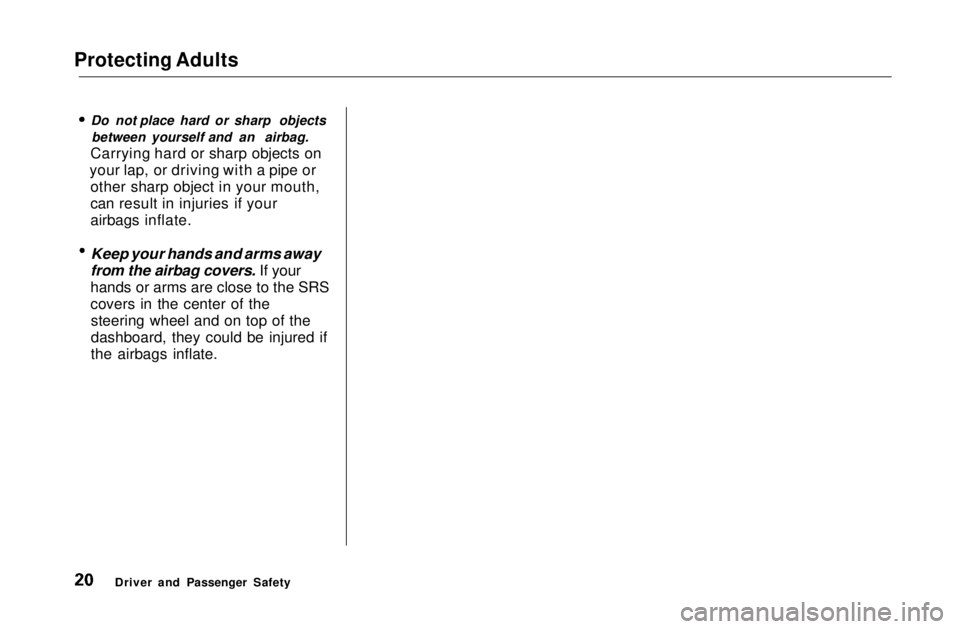
Protecting Adults
Do not place hard or sharp objects
between yourself and an airbag.
Carrying hard or sharp objects on
your lap, or driving with a pipe or other sharp object in your mouth,
can result in injuries if your
airbags inflate.
Keep your hands and arms away
from the airbag covers. If your
hands or arms are close to the SRS
cover
s in the center of the
steerin
g wheel and on top of the
dashboard
, they could be injured if
th
e airbags inflate.
Driver and Passenger SafetyMain Menu Table of Contents s t
Page 22 of 269
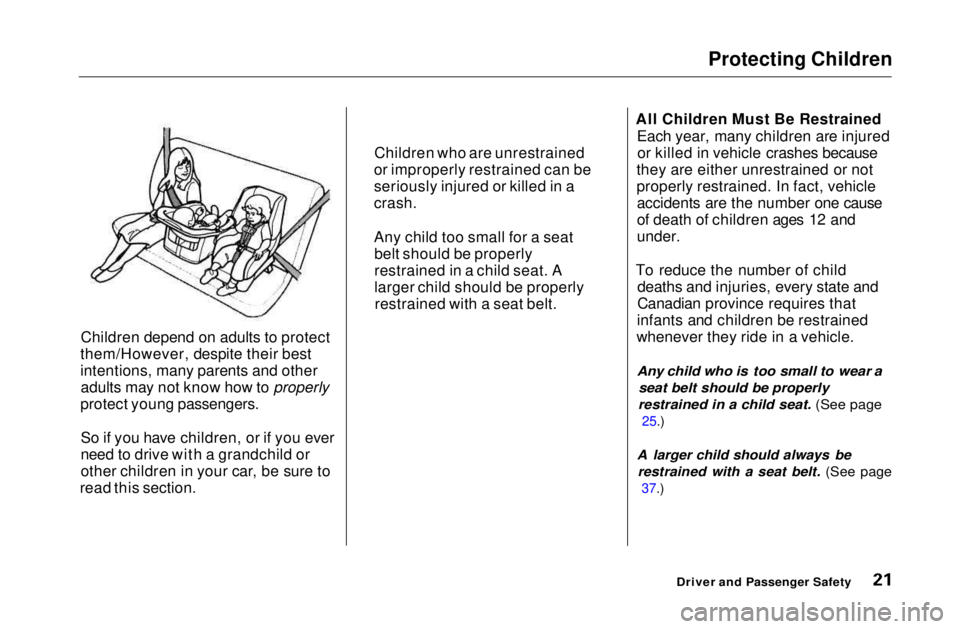
Protecting Children
Children depend on adults to protect
them/However, despite their best
intentions, many parents and other adults may not know how to properly
protect young passengers.
So if you have children, or if you ever
need to drive with a grandchild or
other children in your car, be sure to
read this section. All Children Must Be Restrained
Each year, many children are injuredor killed in vehicle crashes because
they are either unrestrained or not
properly restrained. In fact, vehicle accidents are the number one cause
of death of children ages 12 and
under.
To reduce the number of child deaths and injuries, every state and
Canadian province requires that
infants and children be restrained
whenever they ride in a vehicle.
Any child who is too small to wear a seat belt should be properly
restrained in a child seat. (See page
25.)
A larger child should always be
restrained with a seat belt. (See page
37.)
Driver and Passenger Safety
Children who are unrestrained
or improperly restrained can be
seriously injured or killed in a
crash.
Any child too small for a seat belt should be properly
restrained in a child seat. A
larger child should be properlyrestrained with a seat belt.Main Menu Table of Contents s t
Page 23 of 269
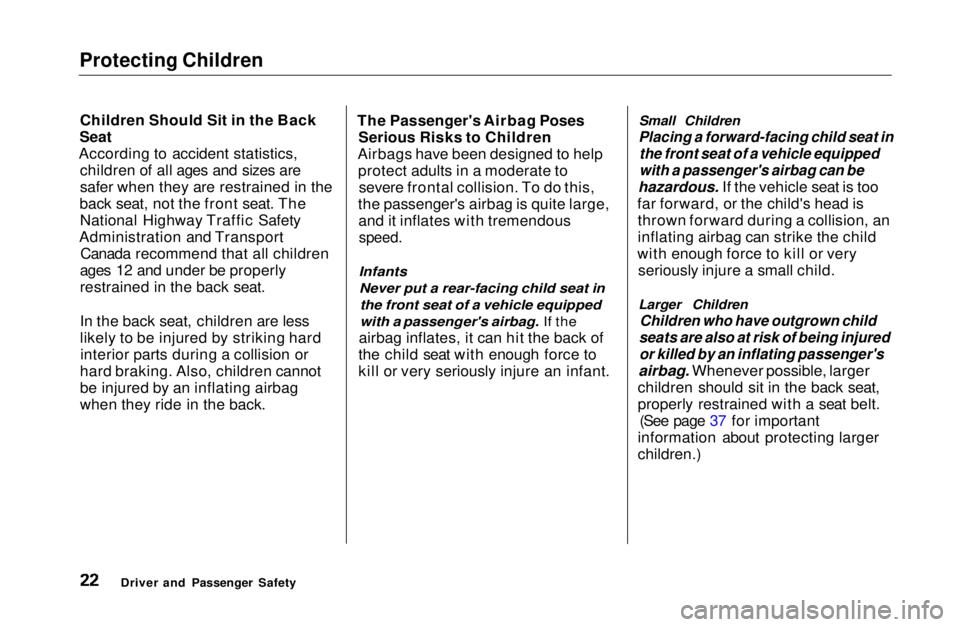
Protecting Children
Children Should Sit in the Back
Seat
According to accident statistics, children of all ages and sizes are
safer when they are restrained in the
back seat, not the front seat. The National Highway Traffic Safety
Administration and Transport Canada recommend that all children
ages 12 and under be properly
restrained in the back seat.
In the back seat, children are less
likely to be injured by striking hard interior parts during a collision or
hard braking. Also, children cannot
be injured by an inflating airbag
when they ride in the back. The Passenger's Airbag Poses
Serious Risks to Children
Airbags have been designed to help protect adults in a moderate to severe frontal collision. To do this,
the passenger's airbag is quite large, and it inflates with tremendous
speed.
InfantsNever put a rear-facing child seat in the front seat of a vehicle equipped
with a passenger's airbag. If the
airbag inflates, it can hit the back of
the child seat with enough force to
kill or very seriously injure an infant. Small Children
Placing a forward-facing child seat in the front seat of a vehicle equipped
with a passenger's airbag can be
hazardous. If the vehicle seat is too
far forward, or the child's head is thrown forward during a collision, an
inflating airbag can strike the child
with enough force to kill or very seriously injure a small child.
Larger Children
Children who have outgrown child
seats are also at risk of being injured or killed by an inflating passenger's
airbag. Whenever possible, larger
children should sit in the back seat,
properly restrained with a seat belt. (See page 37 for important
information about protecting larger
children.)
Driver and Passenger SafetyMain Menu Table of Contents s t
Page 24 of 269
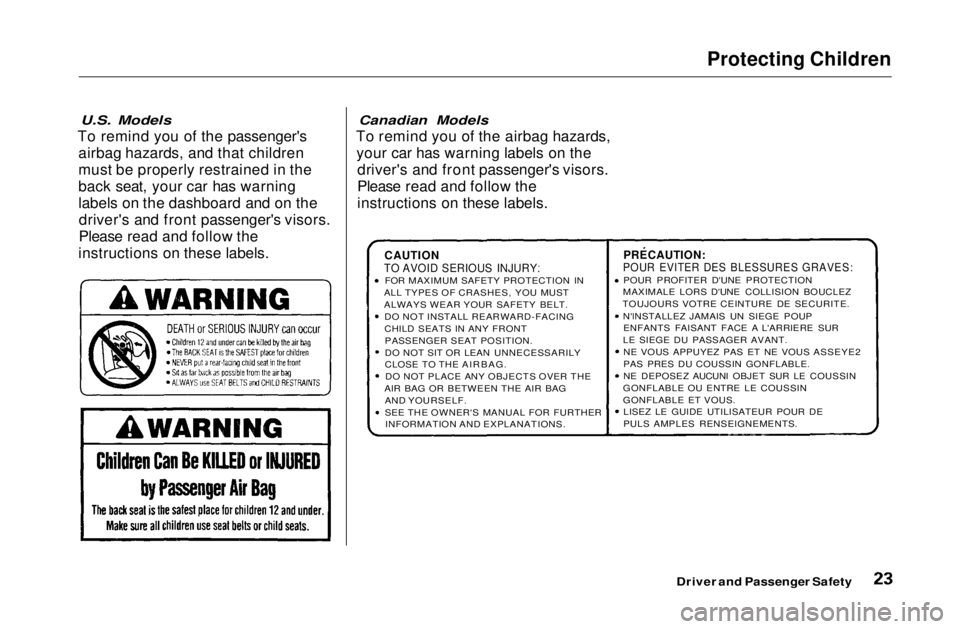
Protecting Children
U.S. Models
To remind you of the passenger's airbag hazards, and that children
must be properly restrained in the
back seat, your car has warning
labels on the dashboard and on thedriver's and front passenger's visors.
Please read and follow the
instructions on these labels.
Canadian Models
To remind you of the airbag hazards, your car has warning labels on the driver's and front passenger's visors.
Please read and follow the
instructions on these labels.
Driver and Passenger Safety
CAUTION
TO AVOID SERIOUS INJURY.
FOR MAXIMUM SAFETY PROTECTION IN
ALL TYPES OF CRASHES, YOU MUST
ALWAYS WEAR YOUR SAFETY BELT. DO NOT INSTALL REARWARD-FACING
CHILD SEATS IN ANY FRONTPASSENGER SEAT POSITION.
DO NOT SIT OR LEAN UNNECESSARILY
CLOSE TO THE AIRBAG.DO NOT PLACE ANY OBJECTS OVER THE
AIR BAG OR BETWEEN THE AIR BAG AND YOURSELF.
SEE THE OWNER'S MANUAL FOR FURTHERINFORMATION AND EXPLANATIONS.
PRECAUTION:
POUR EVITER DES BLESSURES GRAVES:
POUR PROFITER D'UNE PROTECTION
MAXIMALE LORS D'UNE COLLISION BOUCLEZ
TOUJOURS VOTRE CEINTURE DE SECURITE.
N'lNSTALLEZ JAMAIS UN SIEGE POUPENFANTS FAISANT FACE A L'ARRIERE SUR
LE SIEGE DU PASSAGER AVANT. NE VOUS APPUYEZ PAS ET NE VOUS ASSEYE2
PAS PRES DU COUSSIN GONFLABLE.
NE DEPOSEZ AUCUNI OBJET SUR LE COUSSIN
GONFLABLE OU ENTRE LE COUSSIN
GONFLABLE ET VOUS. LISEZ LE GUIDE UTILISATEUR POUR DE
PULS AMPLES RENSEIGNEMENTS.Main Menu Table of Contents s t
Page 25 of 269
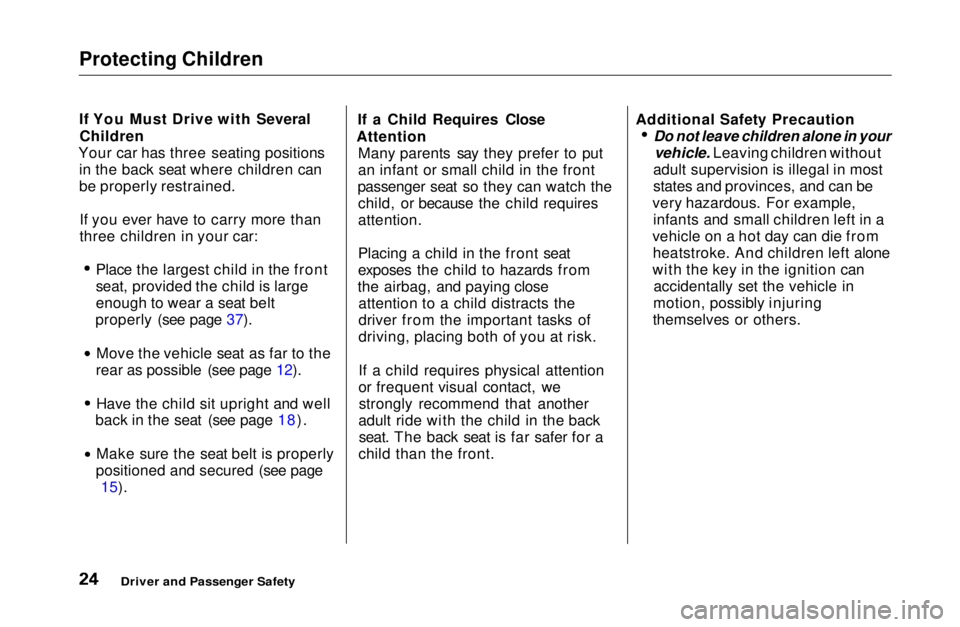
Protecting Children
If You Must Drive with Several
Children
Your car has three seating positions in the back seat where children can
be properly restrained.
If you ever have to carry more than
three children in your car: Place the largest child in the front
seat, provided the child is large
enough to wear a seat belt
properly (see page 37). Move the vehicle seat as far to the
rear as possible (see page 12). Have the child sit upright and well
back in the seat (see page 18). Make sure the seat belt is properly
positioned and secured (see page 15). If a Child Requires Close
Attention Many parents say they prefer to put
an infant or small child in the front
passenger seat so they can watch the child, or because the child requires
attention.
Placing a child in the front seat
exposes the child to hazards from
the airbag, and paying close attention to a child distracts the
driver from the important tasks of
driving, placing both of you at risk.
If a child requires physical attention
or frequent visual contact, westrongly recommend that another
adult ride with the child in the back seat. The back seat is far safer for a
child than the front. Additional Safety Precaution
Do not leave children alone in your
vehicle. Leaving children without
adult supervision is illegal in most
states and provinces, and can be
very hazardous. For example, infants and small children left in a
vehicle on a hot day can die from heatstroke. And children left alone
with the key in the ignition can accidentally set the vehicle in
motion, possibly injuring
themselves or others.
Driver and Passenger SafetyMain Menu Table of Contents s t
Page 26 of 269
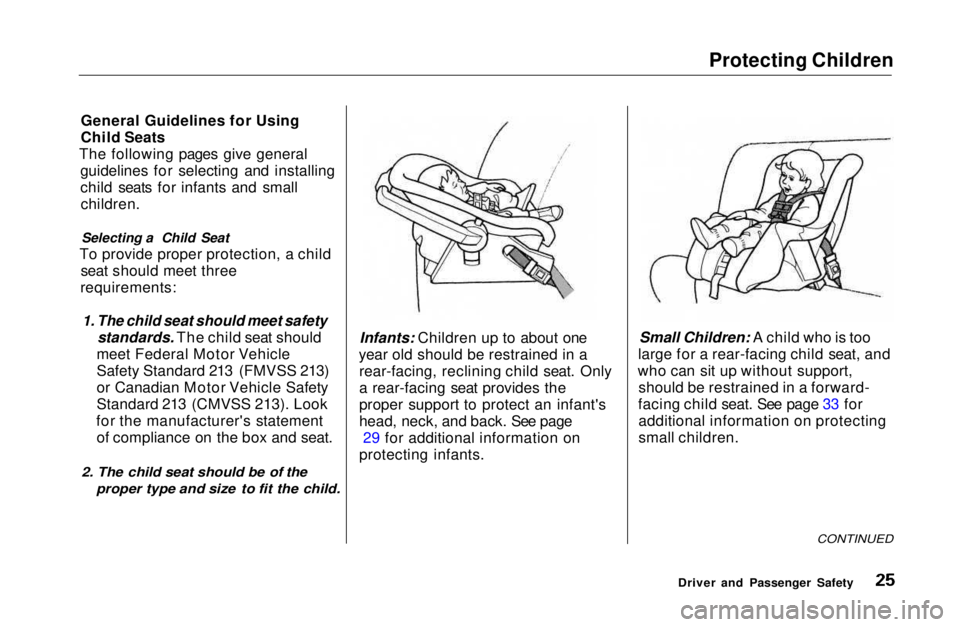
Protecting Children
General Guidelines for Using
Child Seats
The following pages give general guidelines for selecting and installing
child seats for infants and smallchildren.
Selecting a Child Seat
To provide proper protection, a child seat should meet three
requirements:
1. The child seat should meet safety
standards. The child seat should
meet Federal Motor Vehicle
Safety Standard 213 (FMVSS 213)
or Canadian Motor Vehicle Safety
Standard 213 (CMVSS 213). Look
for the manufacturer's statement of compliance on the box and seat.
2. The child seat should be of the
proper type and size to fit the child.
Infants: Children up to about one
year old should be restrained in a rear-facing, reclining child seat. Only
a rear-facing seat provides the
proper support to protect an infant's
head, neck, and back. See page 29 for additional information on
protecting infants. Small Children: A child who is too
large for a rear-facing child seat, and
who can sit up without support, should be restrained in a forward-
facing child seat. See page 33 for additional information on protecting
small children.
CONTINUED
Driver and Passenger SafetyMain Menu Table of Contents s t
Page 27 of 269
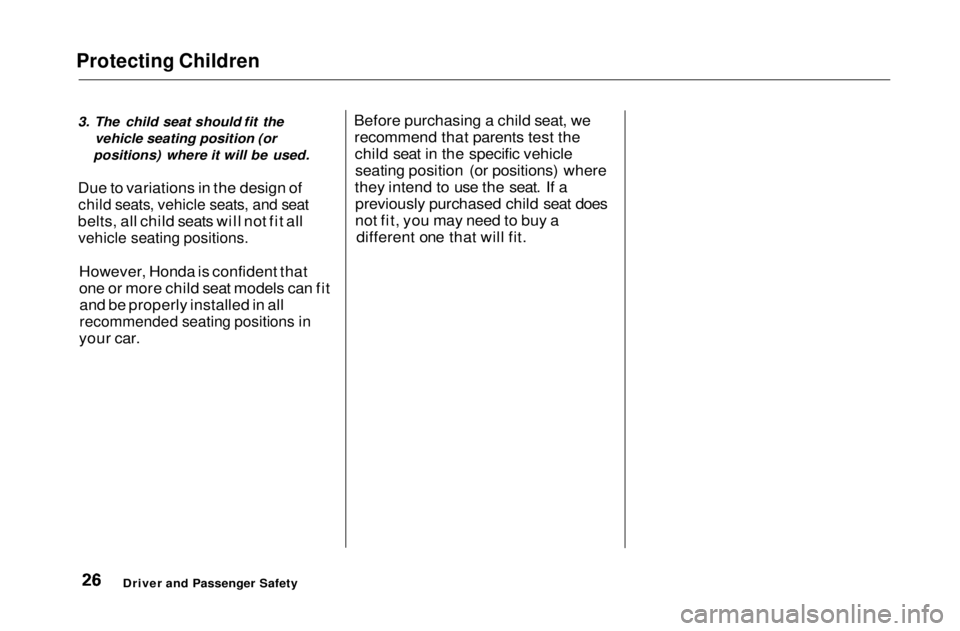
Protecting Children
3. The child seat should fit the vehicle seating position (or
positions) where it will be used.
Due to variations in the design of
child seats, vehicle seats, and seat
belts, all child seats will not fit all
vehicle seating positions.
However, Honda is confident that
one or more child seat models can fitand be properly installed in all
recommended seating positions in
your car. Before purchasing a child seat, we
recommend that parents test thechild seat in the specific vehicleseating position (or positions) where
they intend to use the seat. If a previously purchased child seat does
not fit, you may need to buy a different one that will fit.
Driver and Passenger SafetyMain Menu Table of Contents s t
Page 28 of 269
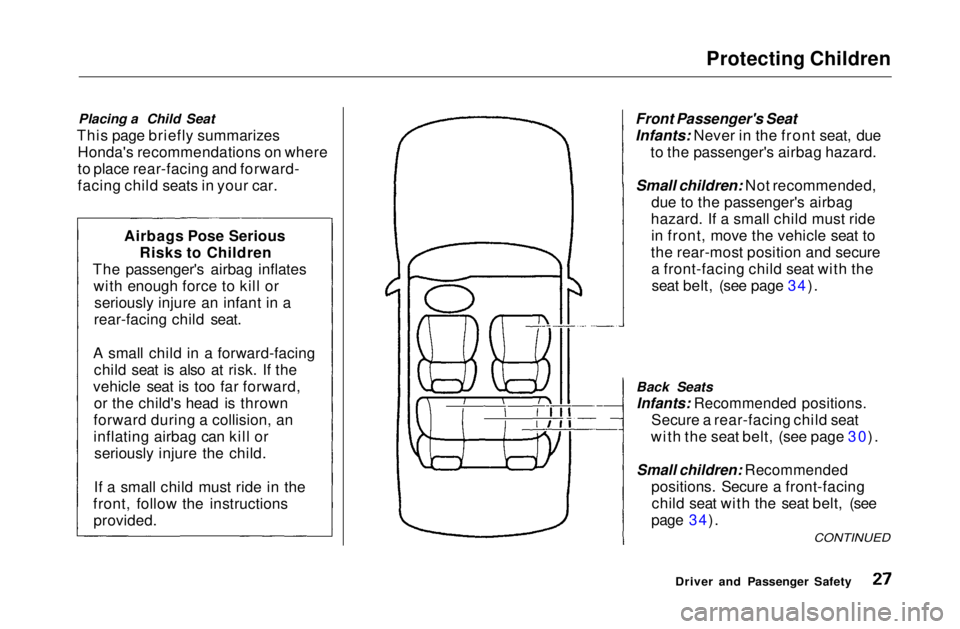
Protecting Children
Placing a Child Seat
This page briefly summarizes Honda's recommendations on where
to place rear-facing and forward-
facing child seats in your car.
Front Passenger's Seat
Infants: Never in the front seat, due
to the passenger's airbag hazard.
Small children: Not recommended,
due to the passenger's airbag
hazard. If a small child must ride in front, move the vehicle seat to
the rear-most position and secure a front-facing child seat with theseat belt, (see page 34).
Back Seats
Infants: Recommended positions.
Secure a rear-facing child seat
with the seat belt, (see page 30).
Small children: Recommended
positions. Secure a front-facingchild seat with the seat belt, (see
page 34).
Driver and Passenger Safety
Airbags Pose Serious
Risks to Children
The passenger's airbag inflates with enough force to kill orseriously injure an infant in a
rear-facing child seat.
A small child in a forward-facing child seat is also at risk. If the
vehicle seat is too far forward, or the child's head is thrown
forward during a collision, an
inflating airbag can kill or seriously injure the child.
If a small child must ride in the
front, follow the instructions provided.
CONTINUEDMain Menu Table of Contents s t
Page 29 of 269
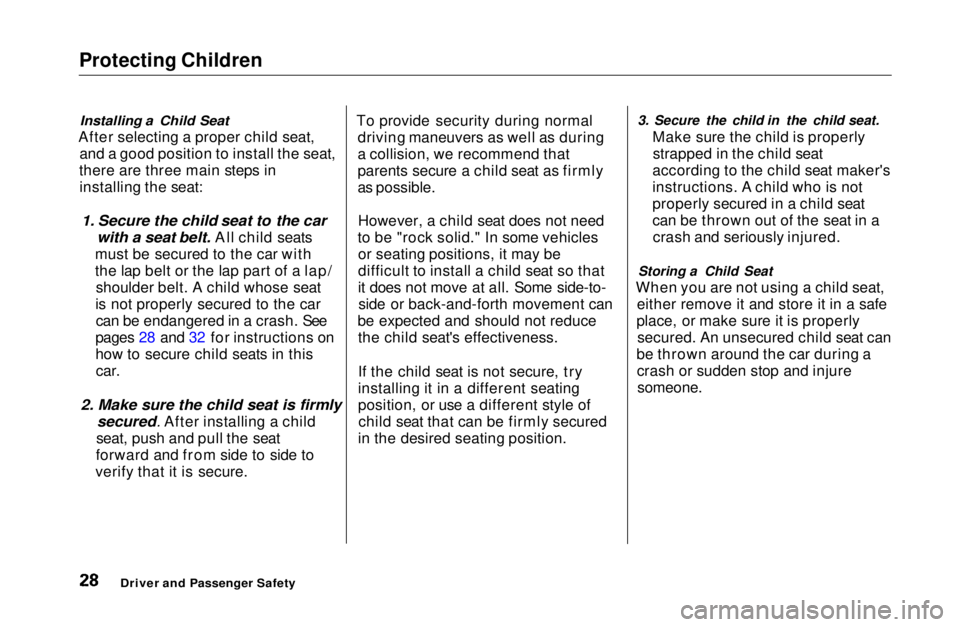
Protecting Children
Installing a Child Seat
After selecting a proper child seat, and a good position to install the seat,
there are three main steps in installing the seat:1. Secure the child seat to the car
with a seat belt.
All child seats
must be
secured to the car with
the lap belt or the lap part of a lap/ shoulder belt. A child whose seat
is not properly secured to the car can be endangered in a crash. See
pages 28 and 32 for instructions on
how to secure child seats in this car.
2. Make sure the child seat is firmly
secured
.. After installing a child
seat, pus h
and pull the seat
forward and from side to side to
verify that it is secure. To provide security during normal
driving maneuvers as well as during
a collision, we recommend that
parents secure a child seat as firmly
as possible.
However, a child seat does not need
to be "rock solid." In some vehicles or seating positions, it may be
difficult to install a child seat so that
it does not move at all. Some side-to-side or back-and-forth movement can
be expected and should not reduce the child seat's effectiveness.
If the child seat is not secure, try
installing it in a different seating
position, or use a different style ofchild seat that can be firmly secured
in the desired seating position. 3. Secure the child in the child seat.
Make sure the child is properlystrapped in the child seat
according to the child seat maker's
instructions. A child who is not
properly secured in a child seat
can be thrown out of the seat in a crash and seriously injured.
Storing a Child Seat
When you are not using a child seat, either remove it and store it in a safe
place, or make sure it is properly secured. An unsecured child seat can
be thrown around the car during a crash or sudden stop and injure
someone.
Driver and Passenger SafetyMain Menu Table of Contents s t
Page 30 of 269
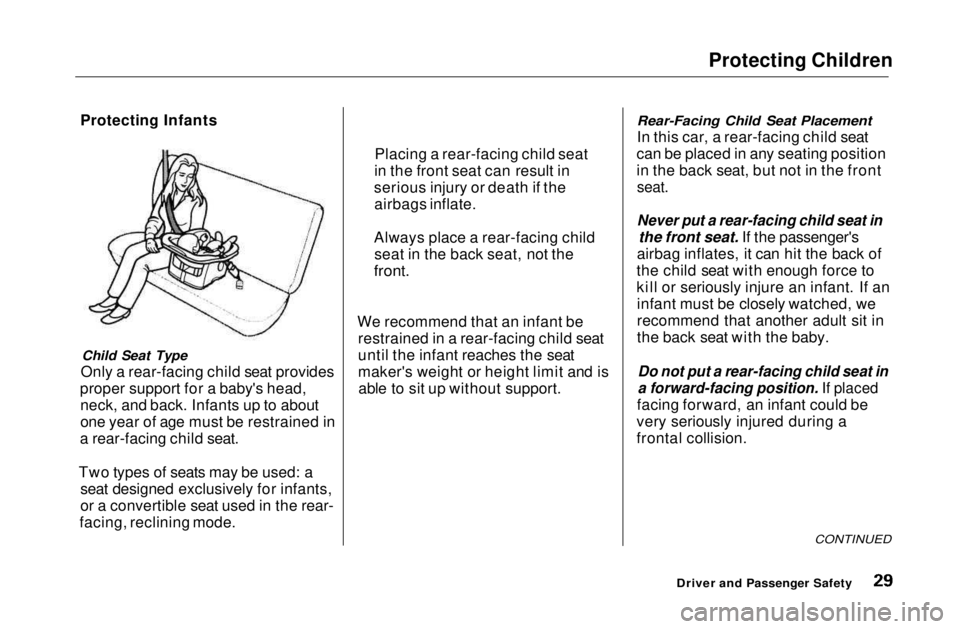
Protecting Children
Protecting Infants
Child Seat Type
Only a rear-facing child seat provides
proper support for a baby's head, neck, and back. Infants up to about
one year of age must be restrained in
a rear-facing child seat.
Two types of seats may be used: a seat designed exclusively for infants,
or a convertible seat used in the rear-
facing, reclining mode. We recommend that an infant be
restrained in a rear-facing child seat
until the infant reaches the seat
maker's weight or height limit and isable to sit up without support.
Rear-Facing Child Seat Placement
In this car, a rear-facing child seat
can be placed in any seating position
in the back seat, but not in the front
seat.
Never put a rear-facing child seat in
the front seat. If the passenger's
airbag inflates, it can hit the back of
the child seat with enough force to
kill or seriously injure an infant. If an infant must be closely watched, we
recommend that another adult sit in
the back seat with the baby.
Do not put a rear-facing child seat in
a forward-facing position. If placed
facing forward, an infant could be
very seriously injured during a
frontal collision.
CONTINUED
Driver and Passenger Safety
Placing a rear-facing child seat
in the front seat can result in
serious injury or death if the airbags inflate.
Always place a rear-facing child seat in the back seat, not the
front.Main Menu Table of Contents s t